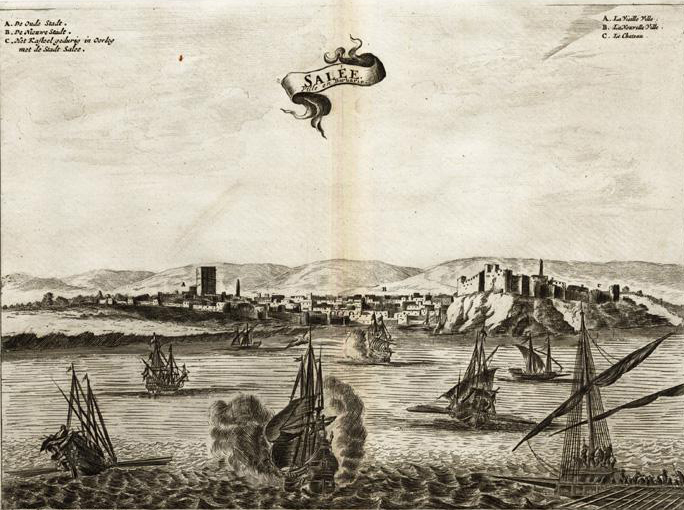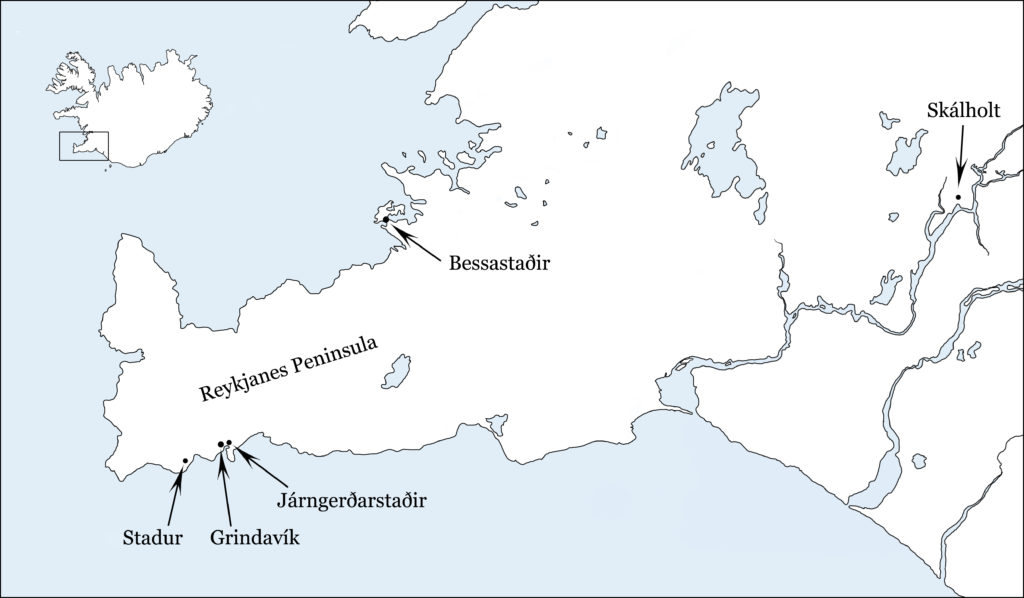(This post is a continuation of The Járngerðarstaðir Farm Family – Parts 1 & 2. If you haven’t done so already, it’s best to read those posts before continuing on here.)
Before leaving Icelandic waters, the Salé corsairs attempted to pillage Bessastaðir, on the Reykjanes Peninsula’s north shore, where the Danish Governor had his residence—and where he amassed the annual taxes he collected for the Danish Crown.
Word had got out about the corsairs’ presence, however, and the Governor had time to mount a sufficiently strong ad hoc defense to drive them off.
They then sailed northwestwards and attacked several English fishing boats.
In the early part of the seventeenth century, the Icelandic cod fishery was at least as important to the English as that of the Grand Banks off Newfoundland. In the summer of 1627, they had no fewer than 150 fishing vessels in Icelandic waters. They also had a pair of warships acting as protective escorts. These English warships would have easily outgunned the Salé corsairs’ vessel. Hearing about the presence of these warships from his newly gotten English captives, Morat Reis decided not to risk a fatal confrontation and, instead, set sail for his home port: Salé, on Morocco’s Atlantic coast.
After a long month’s passage, the corsairs and their Icelandic captives arrived in Salé at the beginning of August.
Salé (known today as Rabat, or Rabat-Salé, the capital city of Morocco), was actually two towns that straddled the mouth of the Bou Regreg River, which flows northwestwards from its headwaters in the Middle Atlas Mountains in the interior of Morocco and empties into the Atlantic Ocean about 170 miles (275 kilometers) south of the Strait of Gibraltar. The town on the north bank was called Old Salé by Europeans of the period. The town on the south bank they called New Salé.
In the image of the town(s) above, New Salé is on the right, on the river’s south bank (the view in the illustration is looking west, with north on the left). The fort atop the promontory was known as the Qasba. The buildings below and beyond the Qasba, along the river’s south bank, constitute the town of New Salé itself.
In the 1620s, New Salé was a thriving corsair port, home to a pirate fleet of thirty or forty vessels, with close connections to other North African corsair centers, especially Algiers. The town itself had a population of perhaps 15,000 people. A significant proportion of these were slaves.
Morat Reis, the leader of the Iceland raid, was no ordinary corsair captain. He was Admiral of the entire Salé corsair fleet. According to the Icelandic text, his return from Iceland with booty and captives was celebrated with salvos of cannon fire and the shrill music of trumpets and bagpipes.
The captives from Iceland, meanwhile, were brought ashore and paraded through the streets of New Salé as a way of advertising that they were up for sale. Then they were auctioned off in the slave market, each to the highest bidder, like cattle. All the members of the Járngerðarstaðir Farm family who had been captured were sold into slavery. Their eventual fates varied, though.
Halldór, Guðrún’s brother, suffered mutilation. According to the Icelandic text, his mouth, nose and hands were slashed, and he was crippled for the rest of his life. He did, however, survive his captivity. After a year or so in servitude, he and his sister Guðrún were ransomed by a Dutch merchant (why the Dutchman would have done this is unclear). The two of them returned to Iceland, by way of Copenhagen, and were home again by the end of 1628.
According to the Icelandic text, “a great sum of money” had been offered to ransom Héðinn, who seems to have been the youngest of Guðrún’s three sons, but his owner refused to sell him. So Héðinn remained stuck in Salé. Guðrún’s other two sons—Jón (Jón Jónsson3) and Helgi—were sold onwards to Algiers.
Jón wrote a series of letters from Algiers. In one of them, dated 1633, he describes how his brother, Helgi, visiting Salé with his owner, found their uncle Jón (Guðrún’s brother, Jón Jónsson2) sprawled in the street, hardly able to move. Jón had been abused by his owner, who overworked him and neither fed nor clothed him adequately. Exhausted and overwhelmed, Jón collapsed and died a short while later.
Helgi wound up serving aboard an Algerian corsair vessel, chained to an oarbench as a galley slave. The commander of the ship was Admiral Jairi Mustafa, whom Jón describes as a “hard man but brave and well liked,” who rarely attacked European ships outright but, instead, captured them by subterfuge—a tactic that would have made him popular (if that is the right word) with the slaves on the oarbenches, since they remained chained up at all times and, in a fight at sea, were helplessly vulnerable.
Héðinn never left Salé. Some of the European captives in North Africa managed to overcome the hardship and loss of their captivity and, against all the odds, fashion new lives for themselves—lives they actually preferred to their old ones. Héðinn was apparently one such, for Jón notes that his brother managed to become a free man in Salé, found work as a carpenter (likely a ship’s carpenter), and had no interested in returning to Iceland.
Jón himself remained in Algiers. As the years passed, his letters became increasingly strident. The last one we have, dated 1635, accuses two Danish emissaries of coming to Algiers with ransom money for the Icelandic captives but, instead, using the money to enrich themselves—one buying sugar, the other hides, to sell at a profit. As Jón puts it despairingly: “It is a pain as sharp as a double-edged sword, and more bitter than death, yes, more hurtful than bloody injuries to know that those who have been here twice to Algiers with our ransom money have used it instead for trade, to make profit for themselves, and have stolen our liberty… leaving behind them only the smoke of their lying words.”
In the winter/spring of 1635-36, the Danish Crown finally sent a ransoming expedition to redeem the Icelandic captives held in Algiers. Helgi was among those ransomed. Everything was carefully documented, and we have a record of his ransom payment (the currency used was Danish rigsdalers, abbreviated as “Rd.” in the record):
______________________________
20 May, 1636
Bought from Mamet Bullique Baschi
Helgi Jónsson, an Icelander
Who himself provided 10 rigsdalers
Cost…………………….Rd. 140—
Port tax…………………Rd. 60—
Total cost……………….Rd. 200—
______________________________
Jón (Jón Jónsson3) was not ransomed. It is not entirely clear why. There is mention in one Icelandic document that some captives were simply too expensive to buy out. Jón had, remember, graduated from university, and his letters show the erudition of a highly educated mind—an asset that surely would have been recognized by his captors. So perhaps he was one of those too-expensive captives. In any case, there is no record that he ever managed to make it out of Algiers. He most likely died there as a slave.
So ends the story of the Járngerðarstaðir Farm family’s travails as slaves.
§§§
Those family members who had died or had been killed included Guðrún’s elderly husband Jón Guðlaugsson (who expired of natural causes), and three of Guðrún’s four brothers, Philippus and Hjálmar, who both likely expired from the wounds they received in the corsair attack, and Jón (Jón Jónsson2) who died in Salé. Héðinn, Guðrún’s youngest son remained in Salé, plying his trade as a carpenter. Her eldest son, Jón, seems to have died in Algiers (though unless some previously undiscovered document shows up, we shall never know for sure). Of Guðrún’s three sons, only Helgi made it back—nearly ten years after the initial attack.
Despite everything, though, life went on for the Járngerðarstaðir Farm family.
Jón Guðlaugsson, Guðrún’s husband, died shortly after—or possibly shortly before—her return to Iceland in 1628. After his death, Guðrún soldiered on and remarried, this time to a widower named Gísli Bjarnarsson, a provost in Grindavík. It was an advantageous match: provosts were important church administrators, each one responsible for multiple parishes. Halldór returned to his wife and children, and, crippled or not, managed to put his life back together. His wife, Guðbjörg Oddsdóttir, was the daughter of a pastor in Grindavík. They had two sons that we know of, one of whom became a pastor, the other a school master. Helgi also returned to Iceland. He married Guðbjörg Gísladóttir. Among their children was Jón Helgason, who became a prominent man in local affairs.
So the Járngerðarstaðir Farm family went on. Two generations of them had been all but wiped out, and those who survived must surely have been traumatized by the events of the 1627 raid and its aftermath. But they survived. They even prospered again—eventually.
Hard times.
Resilient people.

Corsairs and Captives
Narratives from the Age of the Barbary Pirates
View Amazon listing
The Travels of Reverend Ólafur Egilsson
The story of the Barbary corsair raid on Iceland in 1627
View Amazon listing
